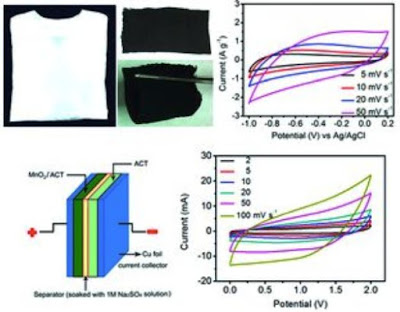BBC News - T-shirts developed that could charge mobile phones
Scientists at the University of South Carolina have found a way to use a cheap T-shirt to store electrical power.It could pave the way for clothes that are able to charge phones and other devices.
Experts predict that new technologies including roll-up smartphones and laptops will be on the market soon.
T-Shirts That Can Charge Mobile Devices - PSFK
Xiaodong Li and Lihong Bao from the University of South Carolina have published a paper in Advanced Materials on how to turn a cotton T-shirt into a source of electrical power, which could provide a way to charge mobile devices on the go.
Their flexible energy storage device was created by soaking a T-shirt in a solution of fluoride, then drying and baking it at a high temperature. The surfaces of the fibers were converted from cellulose to activated carbon, while retaining flexibility. The T-shirt could then act as a supercapacitor and was able to store an electrical charge.
University of South Carolina - News
But Li and Bao took the material even further than that. They then coated the individual fibers in the activated carbon textile with “nanoflowers” of manganese oxide. Just a nanometer thick, this layer of manganese oxide greatly enhanced the electrode performance of the fabric. "This created a stable, high-performing supercapacitor," said Li.
This hybrid fabric, in which the activated carbon textile fibers are coated with nanostructured manganese oxide, improved the energy storage capability beyond the activated carbon textile alone. The hybrid supercapacitors were resilient: even after thousands of charge-discharge cycles, performance didn't diminish more than 5 percent.
"By stacking these supercapacitors up, we should be able to charge portable electronic devices such as cell phones," Li said.
Li is particularly pleased to have improved on the means by which activated carbon fibers are usually obtained. "Previous methods used oil or environmentally unfriendly chemicals as starting materials," he said. "Those processes are complicated and produce harmful side products. Our method is a very inexpensive, green process."
Related

